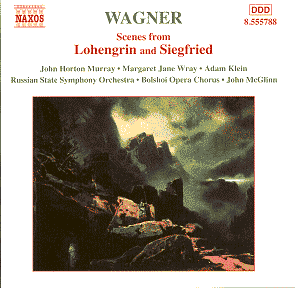This
is a generally enjoyable recital that acts as a platform for the
talents of John Horton Murray, a tenor whose career has already
encompassed Covent Garden, La Scala and The Met. We have the first
two scenes of Act Three of Lohengrin (so why not add ‘Mein
lieber Schwann’ and ‘In fernem Land’, surely the two great tenor
excerpts from this opera?), followed by an offering from more
mature Wagner, the third scene of Act One of Siegfried.
To add to the curiosity value of this disc, the conductor of the
excellent Russian State Symphony Orchestra is John McGlinn, best
known in the UK for his conducting of musicals.
McGlinn
is inclined to mould his tempi according to the moment a little
too much, whereas Wagner writes on the larger canvas. Despite
this, there is much to enjoy. The orchestra is well recorded and
the violins do not sound too strained in excelsis. There
is intensity to the Introduction to the Lohengrin
excerpts, just not quite enough. Murray’s entrance (‘Das süsse
Lied verhält’) is properly piano and sweetly-toned,
but he spoils it almost immediately: the significance of ‘zum
erstenmal allein’ – ‘for the first time alone’ - is not fully
captured. Similarly, ‘Elsa, mein Weib!’ is more vocal narcissism
than passion: Elsa herself (Margaret Jane Wray) is significantly
more impressive. It is only when we arrive at ‘Atmet du nicht
mit mir die süße Düfte’ that Murray becomes more
impassioned. There is no doubting his ability to meet the challenges
of Wagner’s more demanding passages; it is Wray who becomes shrill
under pressure as she begins to beg to know her beloved’s name.
The
wrench in the composer’s musical language when one is suddenly
confronted with Siegfried is significant. A lot can happen
in a quarter of a century, especially with regard to Wagner: in
Lohengrin, the seeds of the composer’s might were inherent,
surfacing from time to time; in Siegfried, his genius is
manifest in every note. All goes very promisingly until the Forging
Song. To begin with, Mime’s pitching is excellent, and he really
does sound agitated. The orchestra flickers and flares evocatively,
evoking Mime’s terror marvellously. Siegfried really does seem
to enter from off-stage, and there is good dialogue between the
two of them. A pity that the orchestra here verges at times on
the scrappy approaching the Forging Song, but it is here at this
most crucial of junctures that the tension sags most. The whole
reading, in fact, is characterised by a fundamentally low-voltage
approach that does Wagner’s dramatic tension no favours at all.
Although Klein is impressive towards the end for his ability to
sing intelligibly at high velocity, Murray’s Siegfried should
surely be more jubilant at the end.
A
mixed bag, then, with impressive moments unfortunately not adding
up to any sort of impressive totality.
It
is good that Naxos has included text and translation. Both singers’
diction is excellent, reflecting the importance of the words they
sing (not a given in all Wagner performance, alas). Never do the
inadequacies of these forces drown the spark of Wagner’s genius,
but there are plenty of greater alternatives on the market, so
unless one requires exactly these excerpts on one disc, it may
be advisable to look elsewhere.
Colin
Clarke
see
also review by Robert
Hugill
